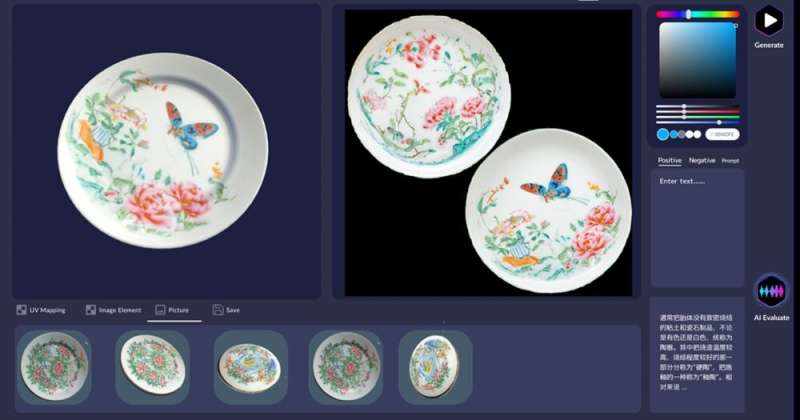
October 16, 2024 by Hong Kong Polytechnic University
Collected at: https://techxplore.com/news/2024-10-harness-generative-ai-cantonese-porcelain.html
The advent of generative artificial intelligence (AI) has sparked concerns about the diminishing value of traditional art forms and the potential for substitution. Nonetheless, through their fusion, they offer new avenues for conserving art and culture while also igniting interest in passing down the heritage from generation to generation.
Embracing generative AI as an innovative tool to expand artistic and cultural horizons, the Hong Kong Polytechnic University (PolyU) researchers have developed a creative painting platform named “Beauty of Cantonese Porcelain” to preserve and educate the artistry of this legacy porcelain.
This handcrafted decorative porcelain showcases the distinct folk art of the Lingnan region, highlighting its intricate and refined painting techniques that embody the rich heritage and ingenuity of traditional Chinese art and craft culture.
Led by Prof. Henry Duh, Associate Dean (Global & Industry Engagement) and Professor of the School of Design, Director of both PolyU-NVIDIA Joint Research Center and Research Center for Art and Culture Technology at PolyU, the research team meticulously collected and processed thousands of images of Cantonese porcelain.
They then used these images to build a robust generative model aimed at making this cultural heritage more accessible and understandable.
Prof. Duh said, “Generative AI can significantly enhance human culture by preserving traditional art forms, fostering artistic innovation, and improving accessibility to art creation. It supports educational initiatives and draws newcomers to intangible cultural heritage while providing tools that require less technical skill.
“However, ensuring ethical practices, transparent AI processes and human supervision are crucial to uphold cultural values and artistic integrity.”
Generative AI’s expansive text-to-image models are the main technology that drives this platform to guide and generate traditional cultural content, such as Cantonese porcelain painting techniques. The models can create images from text descriptions, which is essential for ensuring consistency with the traditional style.
In addition, this innovative platform highlights several technological features, including few-shots fine tuning, layered generation, and symbol element generation.
The research team then integrated the concept of 2D and 3D painting into an art platform, creating a user-friendly interface tailored especially for beginners. This platform assists users in swiftly learning the painting techniques of Cantonese porcelain through an intuitive design. Through real-time evaluation by a large AI model, users receive personalized guidance to enhance their skills as they create artwork.
By merging symbolic painting language with the advanced localized controllable generation, the platform enables users to creatively express their artistic ideas with meticulous details. This ensures that the artworks created closely adhere to the traditional Cantonese porcelain style, thus preserving and promoting the history and culture of Cantonese porcelain through innovative utilization of modern technology.
Using this technology to expand datasets would increase the variety and quantity of training data to include more cultural products and styles, allowing the model to generate a broader range of traditional content. By creating a more intuitive user interface, artists can interact more naturally with the platform while professionals can explore the potential of generative AI to enrich cultural and artistic heritage.
Prof. Duh said, “By collaborating with museums and cultural preservation organizations, it could validate and improve this innovative approach across a wider spectrum of intangible cultural heritage fields. Further enhancements to the multimodal large-scale models with a feedback system that provides insights into the generated content can be used for additional training and refinement of the models.”

Leave a Reply